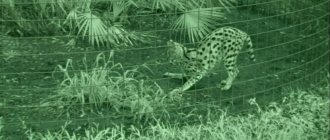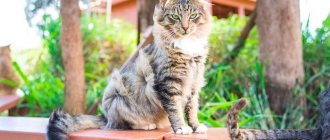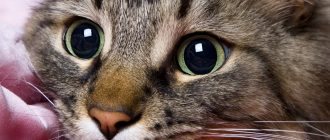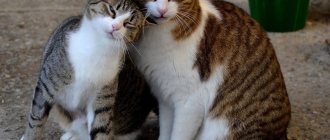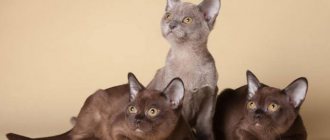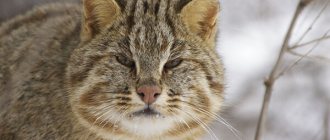Wild ancestors of modern cats
The genotype and phenotype of the domestic cat have evolved over millions of years, so it is impossible to accurately determine its wild ancestor. Many adhere to the version about the origin of cats from creodonts, who lived 50–70 million years ago. This group of extinct animals consisted of predators, scavengers and omnivores. Cats evolved from the first species. The size of these creatures was many times greater than that of lions and tigers. Their victims had virtually no chance of escape, so they caused panic in smaller animals.
Creodont cat ancestor
A branch of miacids separated from the creodonts. They differed from their ancestors in their more developed intelligence, smaller size, elongated plastic bodies, short legs and elongated muzzles, which gave them a resemblance to martens. Miacids were characterized by greater endurance and adaptability to new climatic conditions, but were still less physically developed than modern predators.
Proailurus
Subsequently, miacidae divided into 2 groups, one of which became the ancestor of dogs, the second, proailurus, became the ancestor of civets, the predecessors of cats. The last category of animals had even smaller sizes, greater flexibility and dexterity, which allowed them to live in trees. Subsequently, pseudodelurus evolved from it, from which modern pets and extinct saber-toothed cats originated.
Steppe cat
The closest ancestors of domestic cats are steppe cats, which today live in Africa, Asia, Northern India, Transcaucasia and Kazakhstan. In Russia, these animals can be found in floodplain forests and bushes of the Astrakhan region. Representatives of this breed are somewhat larger than their domesticated counterparts. These animals lead a solitary lifestyle and hunt small animals and rodents.
Known and Unknown
During the existence of cats, many legends and interesting facts about these amazing animals have gathered:
- Cats' ears can rotate 180 degrees.
- Having climbed a tree, inexperienced pets often get stuck there for a long time: their claws are designed in such a way that they can easily climb up, and can go back down the same way, but not upside down.
- They make ten times more sounds than dogs.
- The same sectors of the brain are responsible for emotions in cats, unlike in dogs, as in humans.
- Capable of reaching speeds of up to 50 km/h.
- Cats are record holders for high jumps: they are able to overcome a distance five times their own height.
- Black cats in some European countries, unlike Russia, are given honor and respect.
- They know how to squint their eyes.
- There are already cloned individuals in the world: one of them cost the owner $50,000.
- Their unique ability to find their way back home has not yet been thoroughly studied.
- The meowing of cats is only for people. For their own kind, they have other sounds in their arsenal.
- A fascinating look into the soul has led to the fact that more than half of the people surveyed believe that their pets can read minds.
- Everyone knows that if a cat’s head fits through a hole, then everything else will go through. It's true: they don't have collarbones.
- Their heart beats almost twice as fast as a human's.
- They are extremely prolific: in 7 years, a pair of cats and their offspring can give birth to almost half a million kittens.
- They see poorly at close range: their natural visual acuity is expressed differently than that of humans.
- When a pet, arching its back, rubs against its owner’s legs, it is not so much showing love and respect as it is leaving a secret secreted by its glands on it: this is how the animal secures the status of “one of its own” for the person.
- The magical glow of cat eyes in the dark is explained by the ability to reflect part of the light from the retina.
- The incredible ability of cats to stay alive after falling from a height is due to the ability to group and change the direction of movement during the fall: cats land on all four paws.
Cats are smart, sometimes capricious, affectionate, capricious, and beautiful. Some show devotion, others happily live on their own. They have such facets of character and behavior that they sometimes resemble humans. They cannot be broken - only love and respect will help you live in harmony with them for many years.
Cat as an attraction
Ekaterina Kachura-Falileeva.
At the samovar. 1st half XX century Cats still “work” in the Hermitage - not in the exhibition halls, but in the courtyards and basements. Each cat has a veterinary passport, a bowl and a basket for sleeping. In 2021, the British publication The Telegraph included the Hermitage cats in the list of unusual attractions that you must see if you come to St. Petersburg.
“There are only 50 cats, I set this limit myself. They live in the yard and in basements. We give “extra” cats to good hands. They know their habitats in the basements; there is no need to guide them. We have interviews and filming about cats no less often than about Rembrandt.”
Director of the Hermitage Mikhail Piotrovsky, Literaturnaya Gazeta, 2014
Canadian Sphynxes
Canadian Sphynx
The history of the appearance of sphinxes goes back to ancient times, because it is believed that the Aztecs were the owners of “hairless” cats. Their origin on Earth still remains a mystery.
The Canadian Sphynx arose in 1966, when an ordinary cat gave birth to a completely hairless cub. When he grew up, he was bred with his mother, resulting in both normal and hairless kittens. Then they started crossing hairless kittens, and they created a new breed. The result was two types of animals that were slightly different in appearance. The vitality of the Canadians was low, as gene mutations occurred, and this breed would have died out if not for chance.
One day in a Minnesota cattery, to the great surprise of the owners, a hairless cat was born, and then a year later a hairless cat. After crossing them, viable and healthy offspring were obtained. This gave rise to the breeding of the breed.
History of wild cat domestication
It is known that cats were domesticated later than dogs. Until people began farming, there was no need to keep these creatures. When people began to stock up on food, they were faced with the problem of rodents destroying their supplies. Noticing that cats love to hunt small animals, people began to domesticate them. What are the main stages of cat domestication?
Domestication of cats in the Fertile Crescent 9,500 years ago
Based on the latest research into the genotype of the domestic cat, it was first domesticated in the Fertile Crescent about 10,000 years ago - in the area of the Sumerian civilization, in the lands of modern Iraq, Israel, Syria, Lebanon and Jordan. It is not known whether the Sumerians treated representatives of the cat family as sacred creatures, but there is evidence of the participation of these pets in hunting not only rodents, but also small animals such as hares and even snakes.
Then cats from the Fertile Crescent came to Egypt, where they were given special importance. There were 3 types of cats living in this country: steppe, reed and nocturnal Nubian, images of which can most often be seen on the walls of temples and tombs. There is also a version about the parallel domestication of these pets by the Egyptians. It is known for sure that it was from the Nile Valley that these animals came to Ancient Greece and the countries of North Africa.
The appearance of domestic cats in Europe
The appearance of cats in Europe is due solely to pragmatic considerations. During the heyday of the Egyptian state, it was forbidden to take cats outside its borders. As a maritime power, it traded with many countries, and traders, not wanting to suffer losses due to rodents, took cats with them on ships during their travels, from where they ended up on all continents. It is known that already in the 4th century BC. e. these pets inhabited the territory of modern Great Britain.
In Europe, cats were initially highly valued. In the X–XI centuries. The rulers of some European powers even issued decrees on the rules for treating these animals. With the beginning of the Inquisition, they began to be perceived as companions of witches and exterminated.
In Rus', cats have always been treated well, considering them a symbol of wealth and well-being. It is still a popular custom among the Eastern Slavs today to let a cat be the first to enter a new home, so that it will bring happiness and always protect the home from misfortunes.
Is the domestic cat domesticated or does it just live next to humans?
Cats have been accompanying people for many centuries, but there is no consensus on whether they are domesticated animals. Despite their impressive appearance, these creatures have retained their independent character and good adaptability to the conditions of the wild in almost unchanged form. There are 2 points of view regarding the issue of cat domestication:
Stories of the appearance of purebred cats
Cat breeds appeared thanks to the selective work of people, but certain species arose due to gene mutations. There are also native breeds of pets, that is, those that appeared in isolated areas, they are classified as naturally formed breeds:
- Siberian;
- Angora;
- Thai.
Some breeds are hybrid. They arose as a result of the mating of wild and domestic individuals. The Bengal cat is usually classified as a hybrid cat; Asian leopard wild cats and domesticated pets participated in the creation of the breed.
- the most popular cat breeds;
- the most beautiful cat breeds;
- the most dangerous cats in the world.
Russian Aboriginal cats
Cats spread across the East European Plain almost simultaneously with the settlement of Slavic tribes. As soon as the Eastern Slavs had cities, cats settled in them. Some of the ancient aboriginal breeds in Rus' include the Russian Blue and Siberian cats. The development of such a science as felinology contributed to the emergence of new breeds that appealed not only to people located in the post-Soviet space, but also abroad.
In Russia, two breeds of hairless cats were bred at once - the Sphynx: Donskoy and Peterbald, and Ukrainian breeders bred another species - the Ukrainian Levkoy. In addition, there were:
- Skif-tay-toy-don. This breed was bred in Rostov-on-Don. The name is quite symbolic, if we consider that Scythia is the land on which the Rostov region is now located. Don is a river in the same territory. Toy is a toy that indicates the dwarfism of cats of this breed. Thai - Thai state (Thailand), cats have some similarities with the Thai breed of short-tailed pets. Later, a pair of Russian kittens ended up in an American nursery, after which the breeders came up with a new name - toybob, which translated means toy bobtail, that is, a small pet with a stubby tail.
- The Karelian Bobtail breed standard was first described by the St. Petersburg Commission in 1987. The short tail of the Karelian Bobtail is a dominant mutation that is passed on to generations of animals inhabiting the lands of Karelia. According to one version, the breed originates from Norwegian forest animals. Breed standards allow two subspecies – shorthaired and semi-longhaired. The tail is quite short - from 4 to 13 cm, the hair on it is longer than on the body.
- The Kurilian Bobtail differs from the previous breed in size. The Kurils are more massive, heavier and more muscular than the Karelians. Representatives of the Kuril breed have a curved back, while Karelians have a straight back, with a raised rear. The Kurilian Bobtail's tail is more broken and curved than its Karelian counterpart. The name Kurilian Bobtail indicates the place of origin of the breed. The Kuril Islands, Kamchatka and Sakhalin are the distribution area of short-tailed pets. Pets were identified as a separate breed around the 80s of the last century. In 1995 the breed was recognized by the WCF, in 2004 by the FIFe, and in 2012 by the American TICA.
- The Ural Rex is a native Russian pet with curly hair. The history of the breed begins with the curly-haired pet Vaska, born in the Sverdlovsk region in 1988. Babies of this breed already at 3 months are distinguished by a semi-closed curl of hair. The waviness is clearly visible in six-month-old kittens, but the curl, characteristic specifically for Ural pets, appears in cats older than 2 years. The breed is considered rare, and its representatives are common only in the Sverdlovsk and Yekaterinburg territories. Curly-haired pets are bred not only in Russia, but also in Germany.
- The Neva Masquerade has blue eyes, long hair and a pointed coat, which makes it similar to the Siamese. Felinologists in Russia are breeding the Neva breed. These pets belong to the subspecies of the Siberian cat. Historical information about the breed dates back to the end of the 20th century. The breed has been officially recognized by some international organizations. The name of the breed was invented by St. Petersburg breeders. Nevskaya - by the name of the river on which St. Petersburg is located, and masquerade - by the interesting color of the fur on the face, reminiscent of a masquerade mask.
- The Ussuri Shorthair supposedly originates from Siberian cats accidentally crossed with wild Amur cats. Ussuri pets have not yet been recognized by major international associations. There are very few representatives of the Ussuri, which is why the breed is on the verge of extinction.
Also watch the video of where domestic cats and cats came from:
https://youtube.com/watch?v=11gaLzOaeQ8
CAT GENES
Carlos Driscoll from the National Cancer Institute (USA) and his colleagues from different countries analyzed the genetic material of 979 representatives of domestic and wild cat species: European, Middle Eastern, Central Asian, South African and Chinese desert cats. They published their findings in the journal Science (text in English, free registration required to read). It turned out that all currently existing wild cat species are subspecies of one common species - Felis Silvestris (Latin: Wild Cat). But the DNA of domestic cats coincided with the DNA of only one of these subspecies - the Middle Eastern wild cats Felis Silvestris Lybica (lat. Libyan Wild Cat), living in the remote deserts of Israel and Saudi Arabia. Moreover, the ancestors of absolutely all domestic cats were no more than five individuals, whose descendants, accompanying humans, settled throughout the world.
Photo: Daniele Colombo CC BY-NC-SA 4.0 Pictured: Felis Silvestris Lybica
Thoroughbred or noblewoman
Even in the photo, the largest domestic cat looks menacing, but the Maine Coon is kind. The Persians seem harsh, but in reality they are just couch potatoes. The mysterious slender Siamese can't stand being alone. For the owner, the advantage of the breed is the opportunity to choose a specific disposition that suits the family.
A kitten from a good cattery is the result of selection of producers, including genetic diseases. This increases your pet's chance of a long, healthy life. On the other hand, there are a lot of breed defects that stretch through generations. To many, natural selection seems more reliable, even to the point of the ineradicable myth that noblewomen get sick less often.
But not everyone likes the character traits of outbred cats: they are less attached, more willful, and independent. Kittens taken from the street more often show aggression - motivated, but still not hesitating to let out their claws. Owners of “seasoned” cats have no idea that there are completely different ones who have never left a scratch on their arm or sofa.
Outbred pets tend to go on sprees, returning only to rest. This is not a bad character, but living instincts. Of course, overly self-sufficient cats are found among purebred animals, and noblewomen can be gentle, affectionate, and affectionate like dogs. They are also grateful, understanding the difference between basement life and cozy home life.
Cats are a valuable gift from Nature to humans. They continue to be useful, even abandoned and forgotten. They protect humanity from dozens of diseases. They heal souls with their magical purring - that’s the only reason you can’t help but love them.
Myths, legends and original versions of the origin of cats and their appearance on Earth
Due to their attractive appearance, independent character and special manner of communicating with humans, cats have long been attributed with unusual properties and otherworldly origins.
Many believe that these animals can predict natural disasters and heal their owners. Their ability to group in a jump and almost always land on their paws never ceases to amaze. Where could cats come from?
The Myth of Noah's Ark
Interestingly, according to legend, there were no cats on the ship into which God ordered Noah to take a pair from each type of animal. According to the Old Church Slavonic apocrypha, the devil got into the ark, turning into a mouse, and tried to gnaw its bottom, but after Noah’s prayer, God sent him a cat and a female cat, who killed the pest. According to another version, these animals appeared from the nostrils of a lion when Noah stroked him.
The Divine Origin of Ancient Cats
In Ancient Egypt, cats were attributed to divine origin and, accordingly, were given corresponding significance. The sacred role of representatives of the cat family in ancient Egyptian society is evidenced by numerous frescoes and statues found during excavations. Pharaoh Akhenaten, the husband of the famous Nefertiti, considered himself the son of the sun god, and all cats and cats - his brothers and sisters.
Bastet
It is known that it was customary for the ancient Egyptians to depict the goddess of fertility and hearth, as well as fun and joy, Bastet, in the form of a woman with a cat's head or a cat. In the city of Bubastis, a temple was built in honor of this goddess, and her high priest bore the title of great healer. Bastet, like a cat, sometimes became ferocious and turned into the lioness goddess Sekhmet, who was distinguished by incredible cruelty, but also patronized warriors and healers. It is known about magnificent holidays in honor of Bastet, when pilgrims gathered in Bubastis, where they drank a lot of wine, played musical instruments and sang.
If there was a fire in the house, cats were rescued first as God's messengers, and then the rest of the property. After death, pets were embalmed and buried in richly decorated caskets, but most importantly, mourning was observed. Not to mention killing, the ancient Egyptians were subject to severe punishment and public condemnation for beatings and disrespectful treatment of these animals.
Cats are messengers of extraterrestrial civilization
Ancient Egyptian mythology gave rise to a version about the alien origin of cats. Its adherents believe that a hairless cat flew to Ancient Egypt from another planet, which spoke human language and mentally communicated with people. Having met and fallen in love with a wild steppe cat in the forest, she decided to stay on this planet and acquired offspring from her beloved, from whom all domestic cats subsequently descended. Interestingly, astronauts collected small coin-like formations on the Moon. It turned out that their composition is similar to cat feces.
Family tree and general ancestry
All cats belong to the cat family. Within this family, there are now two subfamilies: big cats (which includes jaguars, lions, leopards and tigers) and small cats (which includes pumas, cheetahs, lynxes, ocelots and domestic cats). Previously, there was a third subfamily - saber-toothed cats, which included Smilodon or saber-toothed tiger, but they became extinct.
READ Mixed food for cats, we eat dry food with a cutlet and French fries
All cats, both small and large, have common features, although this may seem counterintuitive if you compare an ordinary domestic cat with a tiger
It is important to understand that the term “big cats” does not carry any biological meaning regarding the size of the animal. The main common characteristics of all cats are carnivory, developed sociality, and also, as a rule, a nocturnal lifestyle.
No feline has taste buds for the discrimination of sweetness (sweet taste).
To protect barns and deter mice
Vyacheslav Schwartz.
Scene from the home life of the Russian Tsars (Chess game). 1865. State Russian Museum The son of Alexei Mikhailovich Peter I considered cats to be animals that could be useful. In one of the decrees, he ordered “to have cats in the barns, to protect them, and to intimidate mice and rats.” Peter I's favorite cat was named Vasily. The Tsar took it in 1724 from the house of a Dutch merchant who traded in Vologda - Peter the Great often visited him.
Russian and cat are brothers forever!
With the growing popularity of cats, various signs, sayings and proverbs related to cats began to appear. Cats have firmly entered folk tales, perhaps displacing more ancient characters and taking over their functions. The cat's nature made quite a strong impression on the Russians, and cats began to be credited with various magical abilities.
The gloomy and mysterious Cat Bayun is a unique character in Russian fairy tales.
By around the 16th century, almost every family in the Russian Empire already had a domestic cat. The words “cat” and “cat” even appear in historical documents, and not only as independent words, but also in the names of influential people, for example, boyar Fyodor Andreevich Koshka-Kobylin. Also quite often, “cat” is found in the nicknames of ordinary people. For example, in the writs of 1545, a Novgorod peasant named Konstantin the Mouser Cat was noted.
within the earth's surface.
Only cats, due to the special structure of their vocal apparatus, can produce real ultrasounds. They emit ultra-high frequency signals, a weak imitation of which for us is the sound: “Kiss-kiss”
Please note that only cats can make these sounds! This is not typical for any other animal! People can't, animals can't, but cats can do it easily! Ultrasound is only available to cats and kittens!
Why do they need to be able to make such signals? On the earth's surface they make absolutely no sense! The environment simply absorbs them!
And in outer space, ultrasound is, again, the only one capable of carrying important information over vast distances.
Ultra-short wavelengths have the most ultra-high speed!
By the way, modern transmitters modeled by a skilled person also operate in space at ultrahigh frequencies.
And in our time, cats continue to make mysterious sounds...
You can verify this by watching this video.
Cats in Rus'
8 main facts
Today it is absolutely impossible to imagine our life without cats. Some people keep them at home, like our editor-in-chief, for example, while others, like the author of this text, have severe allergies to them and therefore prefer to admire cats from a distance. But even if you start crying and sniffling after just five minutes of communicating with a furry creature, you still love and admire it. It seems that there have always been cats. Or is it not? How, for example, did things stand in medieval Rus'?
When we started looking for information, it turned out that there is not a single large specialized study about ancient Russian cats, and most of what can be found on the Internet are reprints of one (very good) article written about 30 years ago. To this material, the authors, to the best of their imagination, add vivid details, which, however, are usually not confirmed by anything. We firmly decided to figure it out and, separating the wheat from the chaff, collected 8 main facts about the life of seals in Rus'.
Fact No. 1: In Ancient Rus', seals were introduced in the 9th-10th centuries.
The question of when cats were first introduced in Ancient Rus' can be answered by archeology. On the territory of the Rurik settlement, three kilometers from the center of Veliky Novgorod, scientists discovered fragments of the skeletons of six cats in the layers of the 9th-10th centuries. Cats were probably not yet widespread at that time (compare the number of cat bones with the number of dog bones according to the table). Thanks to the finds of archaeologists, we can confidently say that cats definitely lived in the houses of the Russians (and both representatives of the elite lived at the Rurik settlement - the prince and his squad, as well as service personnel) already during the formation of the Old Russian state - that is, during the times of the Prophetic Oleg, Olga and Svyatoslav. As for the keeping of these animals by peasants, we are forced to shrug our shoulders - no traces of the life of cats in the villages have yet been found. However, it must be noted that rural settlements in Eastern Europe have been studied quite poorly, and new discoveries may still await us.
Animal bones found at the Rurik settlement. Images from the article by M. V. Sablin “Fauna of the Rurik settlement (based on the results of excavations in 2000–2011)” // Nosov E. N., Plokhov A. V., Khvoshchinskaya N. V. Rurik settlement. New stages of research. St. Petersburg, 2021.
Fact No. 2: the first mention of seals in the chronicles is related to the fact that they were... eaten.
Sadly, seals are most often mentioned in written sources as food. Of course, in ordinary life they were not eaten - this happened only in an emergency: during famine. The Novgorod First Chronicle describes the terrible events of 1230 as follows: “and the troupe was circumcised by Judahou. and drowsii koninou, psinou. cats. nb those osochishche tako tvoryahou” (NPL, 113 vol.).
The fact that the townspeople started eating cats shows that they had no other food left. This terrible mention (probably the oldest in written sources) dates back to the middle of the 13th century, when the text of the chronicle was written. In general, cat meat was considered unclean, and eating it, according to medieval scribes, was a sign of savagery. Thus, in the Laurentian Chronicle one can find the following description of the wicked tribe: “I eat every kind of filth. mosquitoes and flies. kotki (this form of the word was used on a par with the familiar “cat.” – Ed.), serpent. and a dead man is not a cellar” (LL 1377, 85 a (1096)).
Fact No. 3: cats in Rus' lived in cities and were smaller than their modern counterparts.
The cats of Ancient Rus' were city dwellers. The remains of their bones were found by archaeologists in Kyiv, Old Ryazan, Novgorod, Tver, Yaroslavl, Smolensk[1] and other cities. Researchers believe that these were rather small animals: the average height at the withers did not exceed 30 cm, and ancient Russian cats weighed no more than 4 kg[2]. Although there were exceptions: at the Trinity excavation site in Novgorod, the heel bone of a real giant was found. Its size is larger than average not only for a domestic cat, but also for a wild one. One can only guess where the giant cat came from in the city. Perhaps this is still a wild cat, caught by Novgorodians while hunting, perhaps a domestic cat, donated or brought by foreign merchants.
There is also no clarity about what breeds of cats lived in Ancient Rus'. Firstly, according to researchers, it cannot be argued that in the Middle Ages anyone was specifically involved in the selection and breeding of these animals[3]. Secondly, based on osteological, i.e., bone material (and only this is preserved), it is impossible to judge such important characteristics of the breed as the color and density of fur, temperament, and the ability to catch mice, finally. Most likely, seals in medieval Russian cities lived almost independently and obtained their own food. And no delicacies from your kind owner or periodic trips to the veterinarian. Cat life was filled with hunger and danger - many animals died (or were killed) at a young age. Judging by the marks on the bones, some cats were skinned after death[4] - even a dead animal could be used on the farm. It turns out that the owners were pragmatic about their pets and did not care about them too much. The more surprising is the following fact.
Fact No. 4: in the 14th century, seals were valued several times more expensive than cows and on a par with dogs.
The so-called “Metropolitan Justice”, a legal monument of the 14th-15th centuries, lists the following fines for theft:
“...for a cat 3 hryvnia, for a dog 3 hryvnia, for a mare 60 kun, for an ox 3 hryvnia, for a cow 40 kun, for a third 30 kun, for a hollow half a hryvnia, for a calf 5 kun, for a boran nogata, for a pig nogot, for for a sheep 5 kun, for a stallion hryvnia, for a foal 6 nails”[5].
If we consider a kuna equal to 1/50 of a hryvnia [6], then 3 hryvnia = 150 kuna, which is almost 4 times more than what was demanded for a cow. Even if we take the earlier “rate” of the 11th century - 3 hryvnia = 75 kunas, then this amount is almost 2 times more than the fine for a cow. Surprisingly, the cat was valued as highly as the dog and ox, which were much more closely involved in the human economy. Such a fine looks even more strange if we take into account our assumption that cats survived in ancient Russian cities on their own and were “yard servants”. Maybe the church representatives had some special purebred cats living with them? The source says nothing about this.
Fact No. 5: cats did not save Rus' from the plague.
Contrary to popular belief, which can often be found now on the Internet, the plague epidemic in Rus', where cats were supposedly welcomed, was no less rampant than in Western Europe, where the cat was indeed sometimes considered a companion of the devil and witches. Completing its “tour” across Europe, the great epidemic of the 14th century swept through Rus' in 1352. In 1353, the Grand Duke of Moscow Simeon Ioannovich the Proud and his two young sons died. The population of Moscow decreased significantly, the Pskovites did not have time to bury the dead, and in Glukhov, according to the chronicler[7], no one survived at all. Alas, neither cats nor all the medical practice of the Middle Ages provided any protection from the pandemic that overtook the world.
Fact No. 6: a cat is not always a cozy pet; sometimes it can be very dangerous.
In the “Solikamsk Chronicler” you can find a story about a strange incident that happened in the Verkhtagil fort (a settlement on the Tagil River in the modern Sverdlovsk region) at the end of the 16th century:
“And the governor in it was Ryuma Yazykov from Moscow. And the governor brought with him a larger Kazan cat. And still he kept Ryuma close to him. And that cat went down the throat of the sleeping man and ate him to death in that town...”[8]
So what happened to the unfortunate Ryuma Yazykov? How big did a Kazan cat have to be to gnaw a person's throat? Let’s not forget that Ryuma managed to serve in the Streltsy troops before his appointment, and, without a doubt, knew how to fight very well. According to one version[9], the reed cat, a large predatory animal whose weight can reach 12 kilograms, is called the “Kazan cat” in the chronicles. Jungle cats live in the lower reaches of the Volga, where one of them could theoretically be caught and sold to an unlucky governor. What provoked the cat’s attack on a person - lack of food, poor treatment, or simply the wild nature of a not fully domesticated animal - we can only guess.
According to another version, a representative of a special breed of domestic cats, the Kazan mousecatchers, is to blame for Ryuma’s death. The breed has not survived to this day. According to some reports, these were large animals with a round head, a wide muzzle, a strong neck and a short tail. Kazan cats are well known in connection with the activities of “Peter’s daughter” Empress Elizabeth, who issued the famous decree on sending cats to the court to fight the mice that had proliferated in the Winter Palace. This is how the tradition that still exists today arose of keeping cats in the Hermitage to protect works of art. The story is yet to come about what role Kazan cats played in Russian folklore of the 17th-18th centuries.
Fact No. 7: the first Russian cat, whose image we have preserved, lived in a palace.
“Authentic portrait of a cat of the Grand Duke of Muscovy” is the name of a print by the Czech artist Wenceslas Hollar, dated 1663. After checking the chronology, we can conclude that this is the cat of Alexei Mikhailovich “The Quietest,” father of Peter I. This tsar was generally very fond of animals and game birds, which he kept in large numbers in his country residence Izmailovo. Hollar's engraving is now kept in the National Library of France. Unfortunately, we know almost nothing about the circumstances of its creation. It has been suggested that the image was made by an artist who accompanied the Austrian Baron Augustine Meyerberg during his trip to Russia, and also that Tsar Alexei Mikhailovich himself is depicted as a cat in the print, but these hypotheses are not confirmed.
Fact No. 8: the cat is the main character of the most popular folk picture.
In point No. 6 we already talked about Kazan cats. Let us now look at them not as skilled mousecatchers and dangerous killers, but as heroes of Russian (and not only) folklore. Historian Sait Fyarizovich Faizov believes that the prototype of the legend about the Kazan cat arose in the middle of the 16th century:
“...closest to the hero of the popular print is the Cat of the Kazan Tsar (Khan) from the Mari legend “How the Mari went over to the side of Moscow,” which tells about the siege of the Kazan Kremlin in 1552 by the troops of Tsar Ivan the Terrible. The court cat from this legend managed to overhear how the Mari kings Yylanda and Akpars, besieging the fortress, were digging under the Kremlin wall, and he warned the khan about the danger. Khan, his wife, daughter and cat went through a secret passage to the Kazanka River, got into a boat and safely sailed away from Kazan”[10].
In the second half of the 17th century, lubok appeared in folk culture - painted pictures on wood and metal. One of the most popular popular prints is the funeral of a cat by mice. And on the firewood, in the center of the funeral procession consisting of mice, is not just a cat, but precisely “Kazan cat, Astrakhan mind, Siberian mind...” What does all this mean? Many researchers believe that both the mice and the cat in the picture actually represent someone who cannot be directly named. A popular version claims that the cat being buried by mice is Tsar Peter I, and the authorship of the picture is attributed to the Old Believers, some of whom declared the emperor the Antichrist. S. F. Faizov considers the Cat of Kazan to be a unique image of the Tatars in Russian culture, which arose after the conquest of their three kingdoms (Kazan, Astrakhan and Siberian) by Ivan the Terrible. During the 18th century, the plot of the Cat’s funeral changed, acquiring an increasingly anti-government overtones (for example, the mice on the popular print began to represent various regions of the Russian Empire, many of them had “grievances” against the cat, etc.).
If we try to find out the original meaning of the plot about the funeral of a cat by mice, then its political background should still be relegated to the background. As M. A. Alekseeva notes, in folklore real life events are rarely conveyed directly. The humor in the popular print about the Kazan Cat is not accusatory. This is not “evil” laughter at the authorities, but, in the words of the great cultural critic Mikhail Bakhtin, “buffoonery,” “laughter in the world, where everyone laughs at everyone, including the “laugh-makers” themselves.”[11] Thus, humor, political conflicts and a love for cats, which has not left us to this day, are mixed in the popular consciousness.
[1]Archaeology of ancient Yaroslavl. Riddles and discoveries. 2nd ed. M., 2012. P.214-229.
[2] Zinoviev A.V. Cats of medieval Novgorod the Great and Tver // Archeology and history of Pskov and the Pskov land. Seminar named after Academician V.V. Sedov: Materials of the 63rd meeting. M., 2021. pp. 183-197.
[3]Ibid.
[4]Ibid.
[5] Monuments of Russian law. M.: Gosyurizdat, 1955. Issue. 3: Monuments of law from the period of formation of the Russian centralized state in the 14th–15th centuries. / ed. L. V. Cherepnina.
[6]Numismatic dictionary. 4th edition. Zvarich V.V. Lvov, 1980.
[7] Complete collection of Russian chronicles. T. 10. VIII. A chronicle collection called the Patriarch's or Nikon's Chronicle. / Ed. A. F. Bychkova. – St. Petersburg, 1885. P. 224.
[8] Siberian chronicle code: Note book // Complete collection of Russian chronicles / ed. A. P. Okladnikova, B. A. Rybakova. T. 36: Siberian Chronicles; Part 1: Group of the Esipov Chronicle / preface. N. N. Pokrovsky, E. K. Romodanovskaya. M. 1987. P. 141.
[9] Shashkov, A. T. On the history of the emergence at the end of the 16th century. the first Russian cities and forts on the eastern slopes of the Urals // Ural collection: History. Culture. Religion. Ekaterinburg, 1997.S. 176.
[10] Faizov, S. F. Cat of Kazan: Tatar and Tsar in the perception of the Russian after the “capture” of the Kazan, Astrakhan and Siberian Khanates. https://www.idmedina.ru/books/materials/faizhanov/5/hist_faizov.htm?
[11] Alekseeva, M. A. Wood engraving “Mice dragging a cat to a churchyard” is a monument of Russian folk art of the late 17th - early 18th centuries. // XVIII century collection. : Russian literature of the 18th - early 19th centuries. in the socio-cultural context. T. 14. L., 1983. P. 45-79
Darwin's research
The world-famous scientist Charles Darwin, who devoted his life to questions of origin and natural selection, in 1859, in his book “The Origin of Species,” outlined his theory of where modern dogs came from
Traveling a lot, he noticed that man’s four-legged friend looked like a wild animal living in the area. So, in one territory a domestic dog looks similar to foxes living there, in another - like coyotes, in a third - like wolves
Possible ancestors
Important! But to be based only on Darwin's research today is irrational. After all, the scientist could not know much, since at that time systematics and history were not developed enough to draw meaningful conclusions
Scientists all over the world and at all times have sought to answer the question of where dogs came from and have expressed many theories. However, the question of how dogs appeared has not yet been fully studied. And the final point in these studies has not been set.
Cats in the service of the Empress
In conclusion, it would not be superfluous to recall another interesting fact related to the Russian history of cats. A decree of the Russian Empress Elizaveta Petrovna dated October 13, 1745 orders that the Kazan governor deliver to the then Russian capital eighty of the best cats and cats, as well as a person who would care for them. Such a strange decree had a very simple reason - the imperial palace suffered greatly from mice. After some time, popular rumor embellished this fact with a mass of semi-fairy-tale details. As a result, they began to talk about three hundred cats who were supposed to serve in the palace.
Since the time of Elizabeth Petrovna, cats have become an integral part of St. Petersburg palace life.
True, it remains unknown why this mission was entrusted specifically to the Kazan governor, but this does not change the fact. Perhaps there were many cats in this province or they were distinguished by some outstanding qualities. The latter is supported by the fact that a popular print with the title “Kazan Cat” has survived, indirectly indicating the popularity of Kazan cats among the widest segments of the Russian population.
If you find an error, please select a piece of text and press Ctrl+Enter.
When did the domesticated cat appear?
There are many opinions about how the domestic cat appeared and who was the first to domesticate this animal:
There is an opinion that the domestication of such animals began precisely with their steppe species.
- Some believe that cats were domesticated by the Egyptians. In the history of ancient Egypt there is information that seals were royal animals and were worshiped.
- Another version is that 10-12 thousand years ago people stopped wandering and began to lead a sedentary lifestyle. Then the cats began to get closer to them.
- 4000 years ago, the steppe cat was the ancestor; she became the first one to be tamed by man. After this, domesticated cats were brought to Egypt and other countries.
- Some scientists believe that these animals became domesticated when they helped hunt rats and mice and followed people everywhere. Others think that it was cats who tamed humans, and not vice versa.
Disputes on this matter are still ongoing. But approximately the first domesticated cats began to appear 2 thousand years ago. Over time, they spread on earth, began to interbreed, and thus new breeds of cats appeared. Ancient cat pets in Europe appeared in the 1st century BC. Since their habits suit people, they quickly find a common language.
Cats are a luxury
Initially, cats were very expensive, there were few of them, and there was a huge fine for their theft. The church helped to breed cats; cats were settled in monasteries, in rich houses and in royal palaces. Naturally, at first few people could afford to keep these rare (still) animals; it was simply beyond the means of the majority of the population.
Then, over time, there were more and more cats. And tailed rodent destroyers began to be found in many houses, and even in village huts.
